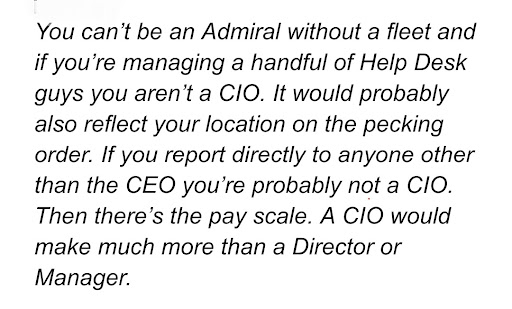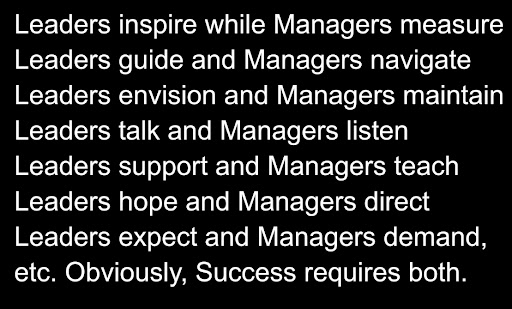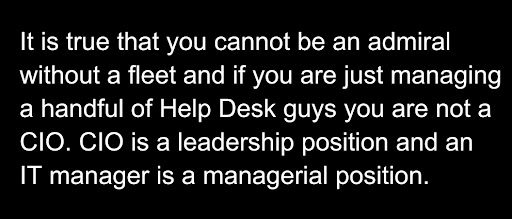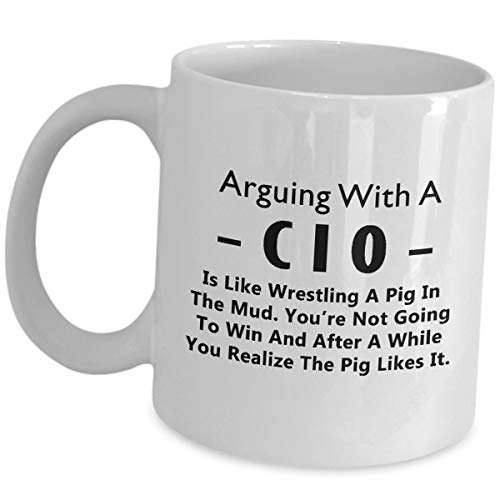CIO and IT Director / Manager:
Like a Chicken Talking to a Duck
(鸡同鸭讲 jī tóng yā jiǎng)

I had a deep discussion a while back with the CIO of a Japanese manufacturer (providing air conditioner units, air purifiers, air curtains, and home central air conditioning) regarding the job title and responsibilities of CIO pondering if Heads of IT or IT Heads are de facto CIOs or not?

Let me state this on the onset here, my answer is big flat NO. As per the title of this article, both the CIO and the IT Head/Manager/Director, are of the feathered species but they are chicken and duck. Domestic ducks can peacefully cohabitate with backyard chickens. Duck and chickens basic feed and shelter requirements are very similar, which makes it possible for them to be coop mates, but there are a few considerations needed to keep in mind when adding waterfowl to a chicken coop.
So the CIO and the IT Director/Head/Manager is akin to the Chinese idiom, 鸡同鸭讲(jī tóng yā jiǎng, that is, Like A Chicken Talking To A Duck.
Read on.
The CIO aka Chief Information Officer, leads the strategic planning and implementation efforts to help keep an organisation’s technologies current, efficient, and effective.
The IT manager role, on the other hand, focuses more on day-to-day operations, maintaining and upgrading current IT systems in the department. The IT Director is the head of the IT department where their primary role is to oversee the daily tasks and operations, keeping and ensuring the lights on, so you speak. Under the guidance of the CIO, the IT Director or Head of IT, maintains adherence to company standard operating procedures (SOPs) and defined support processes.
An anonymous once said:

Behavioural Differences between CIO and IT Director/Manager
Behaviour #1: Tactical versus Strategic Focus
One of the most common differentiators is that the “IT Director/Manager” model tends to focus more on the tactical aspects of IT, whereas a “CIO” model tends to focus much more on the strategic. One role focuses more on daily operations; “keeping the lights on,” making sure everyone has a laptop, email gets delivered, and the Intranet is up.
Whereas the other focuses more on long-term objectives; “growing the business” by making IT a key differentiator in the marketplace, or establishing a nimble application infrastructure that cost-effectively scales to swings in demand.
Behaviour #2: Departmental or Enterprise Function
Organisations which have adopted a “CIO” model often refer to IT as an enterprise function and see it as a true line of business that provides empowering services to all other lines of business. These organisations often see a much deeper involvement by their CIO in areas like business planning, marketing and business development, and often have business specific goals embedded into the IT group’s (and the CIO’s) performance plans.
Organisations with the “IT Director or Manager” model frequently think of IT as a department whose role is delivering support services for the organisation. These organisations view IT as a “cost centre” and do very little to equate that cost with business opportunities or product margins within other lines of business.
Behaviour #3: IT Spend versus IT Investment
The very terminology around IT budget often will indicate which model the organisation is following.
Organisations in the “IT Director/Manager” model typically view the IT budget as “IT spend”. They see these as dollars that must be spent to keep the servers up and the business running.
“CIO” based organisations tend to view the IT budget as an investment in the company. They realise that dollars available to invest are limited, and look for the best places to invest those dollars to help grow the business.
Further, companies with the “IT Director or Manager” model often have no concept of allocating the IT spend across the various lines of business or services offered. Companies with a “CIO” model will understand how their IT spend is allocated across business lines or products due to the fact that they see a direct correlation between the investment in IT and margins within their other business lines.
Behaviour #4: Manager vs Leader
We are all familiar with the old adage “managers focus on doing things right, and leaders focus on doing the right things.” Both of the models we are discussing require a balance of managing and leading, but the differentiator can be found by looking at how the models approach that balance. Since it is focused on the more tactical goal of running the business, the “IT Director/Manager” model tends to favour the manager side of doing things right and de-emphasises the leadership side of the balance.
On the other hand, the “CIO” model favours the leadership side of doing the right things and de-emphasises the manager side of the balance. This allows the CIO to focus more on enterprise, strategic efforts, while delegating much of the day-to-day management to his/her staff. Of course a healthy mix of managing and leading is needed in both models, and you often find individuals in the “IT Director/Manager” roles who are excellent leaders. But the primary job focus, and the performance measures, often tend to be very much aligned to the “IT Directors” as managers and “CIOs” as leaders.
These are the key behaviour differentiators that have been found, and while there are more that may be found when scrutinising these two models, it is believed that the behaviour differences highlighted above tend to be the most common indicator of whether a company uses the “IT Director” model or the “CIO” model.
Looking at these behavioural traits, one can often determine which model is used regardless of job title or organisational structure.
The value of a CIO:
- The CIO possesses a variety of responsibilities including budgeting, security, audits, disaster planning, and strategic planning.
- The CIO acts as a trusted advisor to the executive leadership team and participates as key decisions are being considered.
- The largest contribution of the CIO is usually around strategic planning and oversight of new technology initiatives. Careful analysis of company needs, efficiency gains and return on technology investment enable the CIO to provide appropriate direction for the company.
- A highly regarded CIO has the industry experience and knowledge needed to benchmark against other companies in the same industry and highlight areas for potential improvements.
- Many businesses cannot afford and may not require the full-time services of a CIO. However, executives may need and desire the forward-looking skills that an IT professional can offer.
- A fractional, virtual, or outsourced CIO can often provide the guidance needed for the company at a fraction of the cost. In as little as a few hours per week, a fractional CIO can become a trusted advisor to the CEO, offering key business technology advice needed to control the direction of the organisation.
So, how do you know which one your company needs? Well, that question is very much related to where your company is in its evolutionary cycle. We will dive into that question in the next blog posting.
What do you think the key differences are between the “IT Director/Manager” model and the “CIO” model?
Do you feel an IT Director or IT Head is actually the CIO?
Feel free to share your thoughts, comments and questions with me at my LinkedIn.
In summary and rather a lengthy one but relevant:
- We know that very few organisations can operate without the use of information technologies and systems.
- If technologies and systems are used as a support tool rather than as a strategic one, the organisation is likely missing out on a lot of strategic opportunities such as increased demand, reduced costs, gathering of customer information, stock optimisation, etc. We just described the majority of small-to-medium sized businesses or enterprises (SMB/SME).
- An undeniably forgettable fact, it is not uncommon for employees or end-users to perceive IT staff as the computer guy, the web guy or the techie. This perception, unfortunately, shows the lack of understanding of current organisational developments and frameworks and, more importantly, is a reflection of how they handle these matters within whichever organisations they work (public or private, large or small, for-profit or non-profit). Consequently, this perception is a reflection of how a modern organisation is understood which is usually, not very well, and how it is run which we know, most likely, extremely poorly.
- A CIO and an IT Manager are not the same. Of course, in medium or small size organisations you may find a single individual playing both the CIO and the IT Manager roles and understanding very well the differences between each position. Unfortunately, it is not enough for the person filling this role to know what each role entails. What really matters is how the CEO and senior management perceive the person, if they know which hats he/she is wearing at any particular moment and, most importantly, if his/her comments and contributions are part of the strategic decisions being taken by the organisation.
- When playing the CIO role, either full or part time, the focus should be on how information technologies and systems can help the business strategy and to make sure that there is alignment with that strategy. The IT manager, on the other hand, should make sure that all systems are up and running properly and that the different IT staff members are doing what they are supposed to.


- If your business card says CIO but you do not sit at the senior staff meetings with CEO, CFO, Vice-Presidents, etc. you are not a real CIO. Obviously, organisation size, type of business, etc. are key factors, but by no means are they founded excuses to not allow the CIO to sit in the key strategic meetings.
- A real CIO is supposed to take a strategic view of the organisation, understand the business requirements and facilitate interaction with the other departments. He will have to set the agenda for strategic projects and technologies. For this agenda to work, the IT managers have to make sure that the basic and support technologies are running smoothly.
- In conclusion, organisations that do not have anyone performing CIO activities, even if it is just part time, show a lack of vision and a lack of understanding about the role that information technologies and systems can play today. Information technologies and systems have the capacity to transform the way organisations do business. They are not just solution providers but, even more important, they are enablers. They do not just solve problems but also create value.

Catch When Expert Meets Expert by Eugene Chung articles every bi-weekly Tuesday. Don’t forget to subscribe to stay connected. You are also encouraged to ask questions and seek advice from him.
Share this post
Related Posts

Cybersecurity: Achieving the ‘Hole-in-One’ of Digital Defence
- 07 Nov 2023
- By:Bernadetta Septarini
- Category: When Experts Meet Experts (WEME)
Discover the connection between cybersecurity and sports with Tony Smith, Regional VP at WithSecure. Let’s achieve the ‘Hole-in-One’ of Digital Defense.

Beware of Scare Software aka Scareware
- 21 Nov 2022
- By:Eugene Chung
- Category: When Experts Meet Experts (WEME)
What is Scare Software or Scareware? Learn more about this Social Engineering technique that aimed to scare the victim with ArmourZero mentor Eugene Chung.

Job Hunting Tips for IT Graduates
- 14 Nov 2022
- By:Ts. Saiful Bakhtiar Osman
- Category: When Experts Meet Experts (WEME)
The job market is tough and competitive. Learn some tips on how to do job hunting for IT graduates from ArmourZero’s mentor and expert Ts. Saiful Bakhtiar.

Tips to Successfully Sell a Credible Cybersecurity Solution
- 07 Nov 2022
- By:Eugene Chung
- Category: When Experts Meet Experts (WEME)
How do Cybersecurity sales convince prospects to trust their services and/or products? Learn more about it from ArmourZero’s mentor and expert Eugene Chung.

